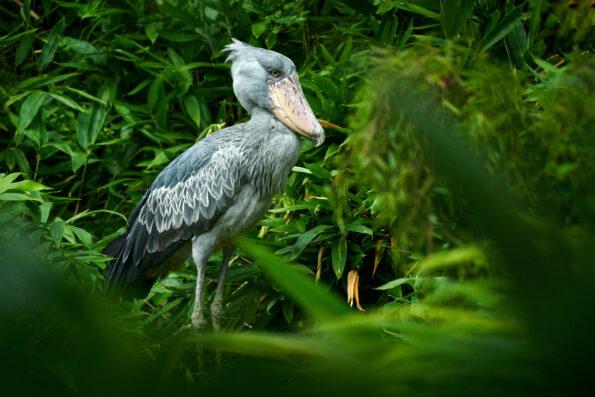This Unique Bird Called The Shoebill Is Classified As Vulnerable, As There Are Only 3,300 To 5,300 Left In The Wild

I think it’s safe to say that the shoebill is the most terrifying-looking bird in the world. Its gray plumage, piercing yellow eyes, unusually large beak, and ability to stay still as a statue for hours make them seem like extremely menacing, man-eating creatures.
But humans don’t need to worry. Shoebills strictly feed on lungfish, catfish, eels, frogs, and baby crocodiles. For the most part, they also don’t threaten humans when approached by them. Instead, they will simply stare back.
The birds will stand motionless and wait for unsuspecting prey to swim by. Once the prey is in their sights, they will use their razor-sharp beaks to make the kill.
The shoebill is named so because of its bill’s resemblance to a Dutch wooden clog. It can reach up to a foot long, making it the third-largest beak of all living birds. Not only are their bills handy for attacking prey, but they also serve as musical instruments.
Shoebills are silent birds for the most part, but they will engage in clapping noises with their bills to greet other shoebills or scare away intruders. They have a wingspan reaching up to eight feet, which helps them with keeping their balance as they soar through the air.
Their long legs make them well-suited for the wet, marshy regions they frequent.
These hefty birds are native to the swamps and wetlands of East Africa. Once referred to as storks, they are now believed to be related to dinosaurs. Furthermore, they are a solitary species and love to have their own space, even during breeding season. When foraging, they do so at opposite ends of their territory.
A pair of shoebills will build their nests on top of floating vegetation and are aggressive defenders of their chosen sites. Females lay up to three eggs, but typically, only a single chick survives even when multiple are hatched. Shoebills raise the eldest chick and leave the younger ones to die.
This unique species of bird is classified as Vulnerable. The International Union for Conservation of Nature estimates that there are between 3,300 and 5,300 shoebills left in the wild.

ondrejprosicky – stock.adobe.com- illustrative purposes only
Their population continues to decline due to hunting, habitat loss, climate change, and the illegal live bird trade.
If true crime defines your free time, this is for you: join Chip Chick’s True Crime Tribe
Size Does Matter: How To Choose The Perfect Rug For Every Room In Your Home
Sign up for Chip Chick’s newsletter and get stories like this delivered to your inbox.
More About:Animals





